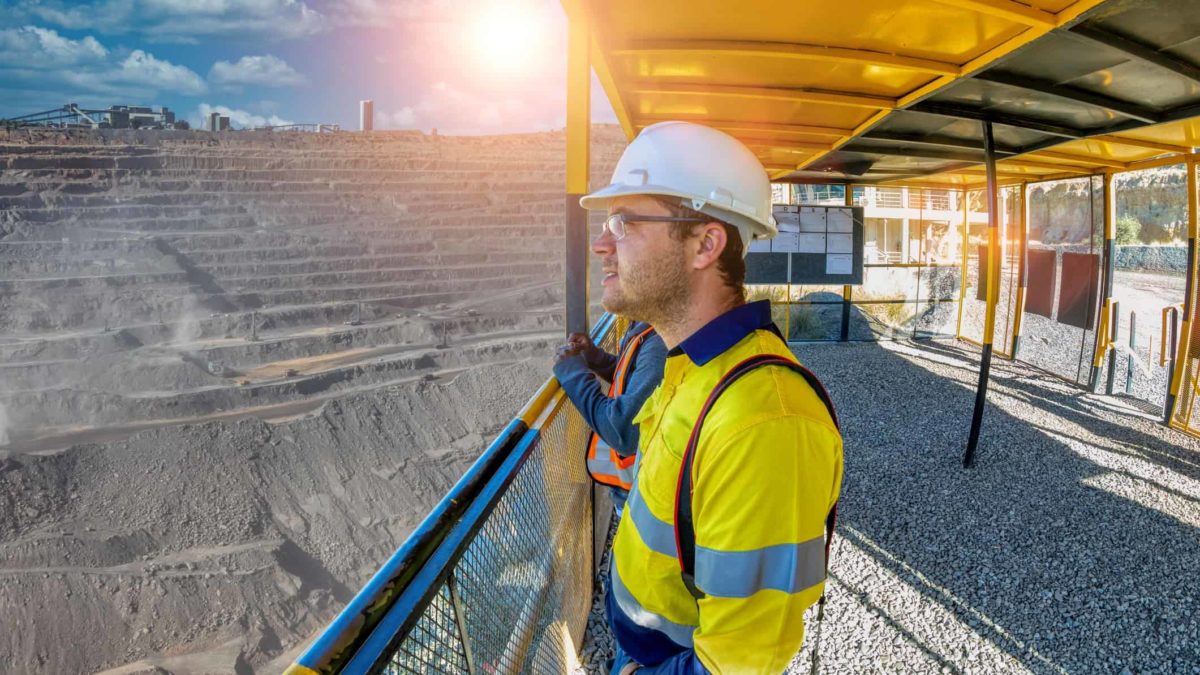ASX 200 mining shares represent nearly a quarter of the entire S&P/ASX 200 Index (ASX: XJO), so it's no wonder most Australians have some exposure to them either directly or via their superannuation investments.
Australia is a world leader in resources exploration and development. We've got a lot of natural metals and minerals in the ground, and we're really, really good at extracting, processing, and selling them to the world.
Mining contributes 13.7% to our gross domestic product (GDP) and directly employs more than 250,000 Australians. Metals, minerals, and energy resources make up more than two-thirds of our exports.
In other words, energy and mining is humungously big business in Australia.
In fact, alongside low unemployment, booming commodity prices and larger tax receipts from ASX 200 mining companies are largely to thank for the forecasted first budget surplus in 15 years.
Australia exported resources worth a record $422 billion in FY22. Our biggest customer was China, with $140 billion worth of exports going there.
The next largest customer is Japan, worth $54 billion to us, and South Korea, worth $33 billion to us.
Given China dwarfs them, you can understand why ASX resources analysts pay such close attention to the goings on in the red country.
And also why it's so significant that Federal Trade Minister Don Farrell has flown to China this week to push for a full resumption of exports for wine, barley, and other Aussie goods.
Aussie investors love ASX 200 mining shares
Given mining companies are such dominant players in our economy, Australian investors have long seen ASX 200 mining shares as their ticket to a financially secure retirement.
The smaller mineral explorers can deliver share price growth as they develop their assets. In contrast, the big, established miners can deliver a bit of growth and, more so, safe and reliable dividends, often with full franking.
Given so many of us invest in them, it would be great to have a crystal ball for their performance over the next five years, right?
Glad you asked.
Once a year, the Federal Department of Industry, Science and Resources publishes a report detailing its five-year outlook for the mining and energy sectors.
This includes official predictions for commodity prices on the full range of metals and minerals we dig up based on current and anticipated global demand trends.
Given ASX 200 mining shares go up and down in line with their associated commodity prices, these predictions could give us a pretty decent clue as to what to expect from our investments in the short to medium term.
Helpful, right? Well, that five-year outlook was recently published, and we've got all the details for you.
Let's dig in.
Commodity price predictions
The report outlines the Government's forecasts for commodity prices over the next five years. There is a realised price for FY22, which you can compare to the forecast prices for FY23 and FY28.
You'll get an idea of the anticipated direction of each commodity price based on the change between FY23 and FY28.
Iron ore prices (62% fe)
FY23: US$97 per tonne (down from US$119 per tonne in FY22)
FY28: US$69 per tonne
Examples of ASX 200 iron ore shares affected: BHP Group Ltd (ASX: BHP), Fortescue Metals Group Ltd (ASX: FMG), Rio Tinto Ltd (ASX: RIO), Champion Iron Ltd (ASX: CIA)
LNG prices
FY23: $21 per gigajoule (up from $16 per gigjoule in FY22)
FY28: $13 per gigajoule
Brent crude oil prices
FY23: US$89 per barrel (down from US$91 per barrel in FY22)
FY28: US$75 per barrel
Examples of ASX energy and oil shares affected: Woodside Energy Group Ltd (ASX: WDS), Santos Ltd (ASX: STO), Beach Energy Ltd (ASX: BPT), Ampol Ltd (ASX: ALD)
Metallurgical & thermal coal prices
Metallurgical
FY23: US$296 per tonne (down from US$387 per tonne in FY22)
FY28: US$185 per tonne
Thermal
FY23: US$313 per tonne (up from US$245 per tonne in FY22)
FY28: US$103 per tonne
Examples of ASX 200 coal shares affected: Whitehaven Coal Ltd (ASX: WHC), Yancoal Australia Ltd (ASX: YAL), New Hope Corporation Limited (ASX: NHC), South32 Ltd (ASX: S32)
Gold prices (LBMA PM)
FY23: US$1,798 per ounce (down from US$1,832 per ounce in FY22)
FY28: US$1,713 per ounce
Examples of ASX 200 gold shares affected: Newcrest Mining Ltd (ASX: NCM), Northern Star Resources Ltd (ASX: NST), Evolution Mining Ltd (ASX: EVN)
Copper prices
FY23: US$8,406 per tonne (down from US$9,645 per tonne in FY22)
FY28: US$9,954 per tonne
Examples of ASX copper shares affected: Sandfire Resources Ltd (ASX: SFR), South32, BHP (especially following the Oz Minerals takeover), Rio Tinto
Alumina & aluminium prices
Alumina
FY23: US$345 per tonne (down from US$381 per tonne in FY22)
FY28: US$350 per tonne
Aluminium
FY23: US$2,388 per tonne (down from US$2,891 per tonne in FY22)
FY28: US$2,391 per tonne
Examples of aluminium shares affected: Alumina Limited (ASX: AWC), Rio Tinto, South32
Lithium spodumene ore prices
FY23: US$4,104 per tonne (up from US$1,488 per tonne in FY22)
FY28: US$2,700 per tonne
Examples of ASX 200 lithium shares affected: Pilbara Minerals Ltd (ASX: PLS), Allkem Ltd (ASX: AKE), Core Lithium Ltd (ASX: CXO), Liontown Resources Ltd (ASX: LTR), Sayona Mining Ltd (ASX: SYA)
Nickel prices
FY23: US$24,414 per tonne (up from US$23,594 per tonne in FY22)
FY28: US$21,313 per tonne
Examples of ASX nickel shares affected: IGO Ltd (ASX: IGO), Nickel Industries Ltd (ASX: NIC), BHP, South32
Uranium prices
FY23: US$51 per pound (up from US$45 per pound in FY22)
FY28: US$67 per pound
Examples of ASX uranium shares affected: Rio Tinto, Paladin Energy Ltd (ASX: PDN), Boss Energy Ltd (ASX: BOE), Deep Yellow Ltd (ASX: DYL)
What does all this mean for ASX 200 mining shares?
It's important to remember that commodity prices are only one factor in the earnings of miners.
Smaller miners that are in exploration or early production stages can obviously build their products and grow their client base enough to increase their earnings regardless of falling commodity prices.
But in the case of the mega miners, which are running enormous mines at pretty much full capacity, commodity prices have a heavier hand in their earnings prospects and share price movements.
For example, Fortescue is an iron ore pure-play at the moment (hydrogen to come!), and it's not at all uncommon to see the Fortescue share price move exactly in line with the iron ore price. To illustrate, over the past month, the iron ore price has fallen 11.9%, and Fortescue shares have fallen 10.2%.
The outlook for ASX 200 mining shares
Despite a projected fall in many commodity prices over the next five years, Australia is still going to make a motza.
The Federal Government is expecting another record high for export earnings in FY23 at $464 billion.
Earnings will then taper back — despite higher volumes of exports — due to lower commodity prices. The projections are $378 billion of export earnings in FY24 and $328 billion in FY25.
As you can see in the price predictions, global demand is likely to fall for Australia's most traditionally popular metals and minerals like iron ore and coal, and this will occur for a few reasons.
Firstly, there is likely to be a slowdown in the world economy due to higher interest rates. Lower global economic activity means less demand for Australian resources and energy exports.
The International Monetary Fund forecasts world GDP growth of 2.9% in 2023, 3.1% in 2024, and an average of 3.3% for 2025, 2026, and 2027. This compares to growth of 3.4% in 2022.
Secondly, geopolitical tensions tend to impact household and business confidence, which leads to people delaying big purchases like a new car or new business equipment (i.e., items with a high metal content).
What about decarbonisation?
On top of all that, there are the growing global trends of nationalism and decarbonisation.
Many countries are now seeking to become more self-sufficient with their own secure sources of energy and the commodities of industry and technology, given the lessons of COVID-19 and the war in Ukraine.
That means they'll eventually buy fewer of the traditional resources from us, such as coal.
For example, the United States is ramping up its gas liquefaction capacity. Within a couple of years, it will become the world's largest LNG supplier and will likely displace Russian fossil fuels sales to the West.
Now, all of this sounds bad for ASX resources shares. But remember this: We are only at the very start of global decarbonisation. Renewables will not overtake traditional resources any time soon.
No longer all about iron ore, but it'll be a slow transition
It's going to take decades to build enough wind turbines, hydrogen processing plants, and a huge global lithium battery supply chain before countries stop buying Aussie iron ore, coal, and other mining goodies.
What will happen, though, is lower global investment in new fossil fuel supplies. That's going to put a floor under commodity prices as demand slowly tapers off.
Also, remember that decarbonisation is going to support commodity prices for the metals and minerals in low-emission technologies, like lithium, copper, and nickel.
The government says these are "set to trade at relatively high prices" over the next five years. That's because most Western countries are now committed to net zero by 2050, so they're ramping up their decarbonisation efforts.
The US is another example here. It is extremely focused on building a renewable energy supply at home.
The US Inflation Reduction Act contains many attractive incentives to encourage investment in renewable projects like hydrogen production, as well as growing the lithium battery supply chain.
By 2028, it is expected that Australia's exports of lithium and base metals (e.g., aluminium, alumina, copper, nickel, and zinc) will equal the export value of all our coal. Pretty amazing.
While things will keep going in that direction over time, it's worth remembering that in order for countries to build all the projects they need for decarbonisation, they need inputs like steel and energy.
This means ongoing demand for iron ore, coal, and other traditional commodities for some time yet.
What's next with China?
We are still largely beholden to China in terms of demand. So, it's a good thing that the International Monetary Fund expects China to have better economic growth than the rest of us over the next five years.
The IMF predicts 5.2% growth for China in FY23 and 4.5% in FY24. This compares to forecast world GDP growth of 2.9% in FY23, 3.1% in FY24, and an average of 3.3% for FY25, FY26, and FY27.
As we learned this week, the Australian Government expects Australian economic growth of 3.25% in FY23, 1.5% in FY24, and 2.25% in FY25.
The government reckons China may move to stimulate its domestic economy over the next couple of years because its low inflation provides more scope to do that in comparison to other countries.
This would support global commodity prices and generate additional demand for Australian resources in the short term, and that's good for ASX 200 mining shares.
But at the same time, the Chinese Government's concerns over lower population growth and its debt-laden property sector may reduce demand for some commodities — mainly iron ore. Not so good.
However, over the outlook period, the Government thinks any void that reduced Chinese demand might create may be filled by another emerging superpower, India.
The report said:
India is likely to grow as a source of resource and energy commodity demand over the outlook period, as the economy grows and develops further.









